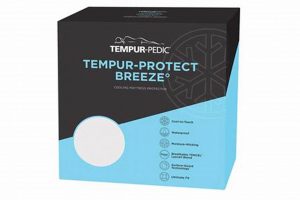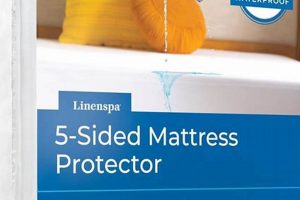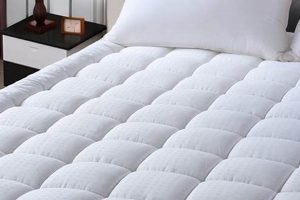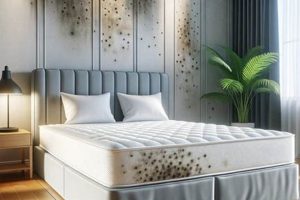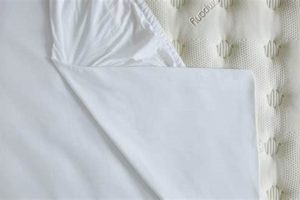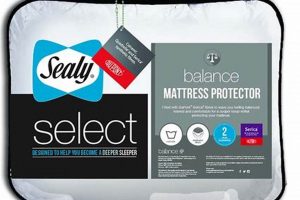A bed covering designed to shield a mattress from liquids and moisture, often constructed with a surface layer derived from bamboo fibers, provides a barrier against spills, sweat, and other potential sources of mattress damage. These covers frequently incorporate a waterproof membrane, typically made of polyurethane or a similar material, to ensure complete protection. A common application involves families with young children or individuals seeking to extend the lifespan of their mattress.
The value of such a product lies in its ability to preserve the integrity of the mattress, preventing stains, odors, and the growth of mold and bacteria. This contributes to a healthier sleep environment and reduces the need for frequent mattress replacements. The use of bamboo fiber offers additional advantages, including breathability and softness, potentially enhancing sleep comfort. Historically, the need to protect mattresses from damage has led to various solutions, evolving from simple cloth coverings to technologically advanced waterproof and breathable materials.
The subsequent discussion will delve into the specific characteristics of materials utilized in construction, examine varying levels of waterproof effectiveness, detail proper care and maintenance procedures, and evaluate relevant certifications and standards. Furthermore, different types available and their specific use cases will be considered.
Usage and Maintenance Guidelines
Adherence to the following guidelines will maximize the lifespan and effectiveness of the mattress encasement.
Tip 1: Proper Installation: Ensure the covering is fitted snugly to the mattress, fully enclosing it. Wrinkles or loose areas may compromise waterproof integrity and comfort.
Tip 2: Regular Cleaning: Launder the encasement according to the manufacturer’s instructions, typically involving machine washing with cold or lukewarm water and gentle detergent. Avoid harsh chemicals or bleach.
Tip 3: Prompt Spill Response: In the event of a spill, immediately blot the affected area with a clean cloth to prevent liquid penetration. Subsequent laundering is often necessary.
Tip 4: Avoid High Heat: When drying, use low heat or air drying. High temperatures can damage the waterproof membrane, reducing its effectiveness.
Tip 5: Periodic Inspection: Regularly examine the encasement for tears, punctures, or signs of wear. Replace if damage is detected to maintain optimal protection.
Tip 6: Consider a Second Layer: For individuals prone to excessive perspiration or spills, an additional absorbent layer, such as a mattress pad, can provide added protection and extend the lifespan of the waterproof encasement.
Tip 7: Storage Considerations: When not in use, store the encasement in a clean, dry location to prevent mold or mildew growth.
Following these guidelines ensures prolonged product performance, maintains a sanitary sleep environment, and protects the investment in the mattress.
The subsequent section will address common concerns and troubleshooting related to these products.
1. Material Composition
The material composition is a critical determinant of a bamboo waterproof mattress protector’s performance and longevity. The term encompasses both the bamboo-derived surface layer and the underlying waterproof membrane. The percentage of bamboo fiber present significantly affects the product’s breathability, softness, and moisture-wicking capabilities. Higher bamboo content generally results in enhanced comfort and temperature regulation. Conversely, the type of waterproof membrane, commonly polyurethane or thermoplastic polyurethane (TPU), dictates the level of liquid protection. Inferior membranes may crack or degrade over time, compromising the protective barrier. For example, a protector with a high bamboo content and a TPU membrane offers a balance of comfort and robust waterproof functionality, while one with a low bamboo content and a cheaper membrane may be less breathable and prone to leakage.
Further analysis reveals that the manufacturing process impacts the final product. Bamboo fibers can be processed using various methods, affecting their texture and durability. Similarly, the lamination process used to adhere the waterproof membrane to the bamboo layer can influence breathability. A poorly executed lamination can create a less breathable product, negating the benefits of the bamboo fibers. Consider a protector where the bamboo fibers are chemically treated, resulting in a harsher feel, or where an inadequate lamination process traps heat, leading to discomfort. These examples underscore the importance of scrutinizing the manufacturing methods and certifications associated with the product.
In conclusion, the material composition is paramount in determining the effectiveness and suitability of a bamboo waterproof mattress protector. The interplay between bamboo fiber content, the type of waterproof membrane, and the manufacturing processes significantly impacts the product’s comfort, durability, and overall performance. Understanding these factors enables informed purchasing decisions and ensures the selected product aligns with individual needs and preferences, despite challenges such as deceptive marketing or inconsistent product labeling. The material’s composition is integrally tied to the protector’s long-term functional value.
2. Waterproof Effectiveness
Waterproof effectiveness constitutes a primary function of a bamboo waterproof mattress protector. The degree to which it prevents liquid penetration directly impacts the longevity and hygiene of the underlying mattress. Failure in this aspect renders the remaining features, such as the bamboo’s breathability, largely irrelevant. A compromised barrier allows fluids like sweat, spills, or bodily fluids to seep into the mattress, fostering microbial growth and potentially voiding warranties. For example, if a protector uses a perforated waterproof membrane, it may initially resist liquids but eventually allow seepage, leading to mold and odor problems within the mattress core.
Assessment of waterproof effectiveness requires considering the hydrostatic head test, which measures the water pressure a fabric can withstand before leakage. A higher hydrostatic head rating indicates superior waterproofing. Different applications demand varying levels of protection; households with infants or individuals managing incontinence require a higher level of waterproof integrity compared to single adults. Consider the practical scenario of a beverage spill; a low-quality protector might only delay penetration, creating a damp environment conducive to bacterial growth. Conversely, a high-quality option would prevent any fluid from reaching the mattress, maintaining its integrity and preventing the need for costly cleaning or replacement.
In summary, waterproof effectiveness is not merely a desirable attribute but a fundamental requirement for a bamboo waterproof mattress protector. It determines the product’s ability to safeguard the mattress from irreversible damage, ensuring a hygienic sleep environment and preserving the investment. Challenges in achieving optimal waterproof performance stem from material degradation over time and manufacturing inconsistencies. Therefore, consumers should prioritize products with certified waterproof ratings and verifiable customer reviews to ensure a reliable level of protection. The long-term value of this product resides in its capacity to defend against contamination, making waterproof effectiveness non-negotiable.
3. Breathability Factors
The breathability of a mattress protector is a critical aspect of its overall comfort and performance, especially when considering a waterproof model incorporating bamboo fibers. It dictates the extent to which air and moisture can circulate through the material, influencing temperature regulation and preventing the buildup of humidity.
- Fiber Structure and Composition
The natural properties of bamboo fibers contribute to breathability due to their inherent porous structure, allowing for enhanced airflow compared to synthetic materials. The weaving pattern and density of the bamboo fabric directly impact ventilation. For example, a looser weave promotes better breathability, while a tightly woven fabric may restrict airflow, even with bamboo fibers. Synthetic components blended with the bamboo can also impede breathability.
- Waterproof Membrane Technology
The waterproof membrane’s construction significantly affects breathability. Traditional waterproof layers, often made of polyurethane, can be impermeable to air, leading to heat retention and discomfort. Modern technologies employ microporous membranes that allow air and water vapor to pass through while preventing liquid penetration. Microporous membranes may degrade over time, diminishing breathability and waterproof capabilities.
- Moisture-Wicking Properties
Effective moisture-wicking transports sweat and humidity away from the body, promoting a cooler and drier sleep environment. Bamboo fibers are known for their moisture-wicking capabilities. This process is diminished when the bamboo layer is saturated or when the underlying waterproof membrane restricts evaporation. The fabric’s capacity to absorb and release moisture influences overall thermal comfort.
- Ventilation Design
Some protectors incorporate design elements to enhance breathability, such as strategically placed ventilation channels or perforated layers. These features facilitate airflow and reduce heat buildup. Ventilation designs must be balanced with waterproof integrity to prevent leakage. The efficacy of ventilation designs depends on the protector’s overall construction and the materials used.
These breathability factors collectively determine the comfort and effectiveness of a bamboo waterproof mattress protector. The interaction between the bamboo fiber’s natural properties, the waterproof membrane’s technology, and the protector’s design dictates the overall sleep experience. Compromises in any of these areas can lead to discomfort, reduced protection, and decreased product lifespan, underscoring the importance of evaluating breathability alongside waterproof capabilities.
4. Maintenance Requirements
Maintenance requirements directly influence the lifespan and continued effectiveness of a bamboo waterproof mattress protector. Adherence to specific cleaning and care protocols prevents degradation of both the bamboo fabric and the waterproof membrane. For instance, improper washing techniques, such as using high heat or harsh detergents, can compromise the membrane’s integrity, leading to cracks and leaks. Similarly, neglecting to promptly address spills can result in stains and potential microbial growth, necessitating more aggressive cleaning methods that further damage the protector. Therefore, maintenance is not merely an ancillary task but an integral component of the product’s overall performance and durability.
Real-life examples illustrate the practical significance of understanding these requirements. A protector consistently laundered according to manufacturer instructions, typically involving gentle cycles and low-heat drying, will likely retain its waterproof properties and structural integrity for an extended period. Conversely, one subjected to infrequent washing or harsh cleaning agents may exhibit premature wear and tear, rendering it ineffective and necessitating replacement. The presence of care labels and clear instructions from the manufacturer becomes essential in guiding users through appropriate maintenance procedures. Neglecting these guidelines creates a direct cause-and-effect relationship, leading to reduced product lifespan and diminished protective capabilities.
In summary, the maintenance requirements of a bamboo waterproof mattress protector are critical for ensuring long-term functionality and hygiene. Understanding and adhering to recommended cleaning and care protocols preserves the integrity of both the bamboo fabric and the waterproof membrane, mitigating premature wear and tear. While challenges may arise due to user error or unclear instructions, prioritizing proper maintenance maximizes the investment and contributes to a healthier sleep environment. The product’s value is directly linked to consistent and appropriate maintenance practices.
5. Health Implications
The interaction between health and mattress protection is significant. The following examines specific health implications linked to the use of mattress protectors constructed with bamboo and waterproof barriers, emphasizing objective risks and benefits.
- Allergen Mitigation
Mattress protectors act as a barrier against allergens, such as dust mites and pet dander, which can accumulate within a mattress. The waterproof layer prevents these allergens from penetrating the mattress core, reducing exposure for sensitive individuals. For example, asthma and allergy sufferers experience decreased symptoms when sleeping on mattresses shielded by effective protectors. However, the protector itself can become an allergen reservoir if not regularly cleaned, negating its benefits.
- Microbial Growth Prevention
The waterproof membrane prevents moisture from sweat and spills from reaching the mattress, inhibiting mold and bacterial growth. Mold spores and bacteria harbored within mattresses trigger respiratory problems and skin irritations. A protector’s efficacy diminishes if the membrane is compromised, creating an environment conducive to microbial proliferation. Prolonged exposure to these microorganisms leads to chronic health issues.
- Chemical Exposure Considerations
The materials used in manufacturing protectors, particularly the waterproof membrane, raise concerns about chemical exposure. Some protectors contain volatile organic compounds (VOCs) or phthalates, which off-gas and potentially affect respiratory health. Certified protectors with low-VOC emissions and phthalate-free membranes minimize these risks. The selection of materials directly influences the potential for adverse health effects.
- Skin Sensitivity and Irritation
The surface material in direct contact with skin can cause irritation or allergic reactions in sensitive individuals. Bamboo fibers possess hypoallergenic properties that reduce the risk of skin irritation compared to synthetic materials. However, dyes and chemical treatments applied to the bamboo fabric provoke adverse reactions in some cases. Choosing protectors with natural, untreated fibers minimizes the potential for skin sensitivity issues.
These health implications collectively underscore the importance of selecting a bamboo waterproof mattress protector that balances allergen reduction, microbial control, minimal chemical exposure, and skin compatibility. While protectors offer potential health benefits, they also present risks associated with material composition and maintenance. Vigilant selection and adherence to care guidelines are crucial for maximizing the positive health outcomes and minimizing potential adverse effects.
6. Lifespan Expectancy
The lifespan expectancy of a bamboo waterproof mattress protector is a critical factor determining its overall value proposition. It represents the duration for which the product effectively performs its intended functions namely, safeguarding the mattress from liquids and allergens while maintaining a comfortable sleep surface. Premature failure of the protector necessitates replacement, negating any initial cost savings. Causes impacting lifespan expectancy include the quality of materials, manufacturing processes, and adherence to recommended care instructions. For example, a protector constructed with a low-grade waterproof membrane may delaminate or crack after only a few wash cycles, while a higher-quality option, properly maintained, can provide several years of reliable service. The expected lifespan directly influences the cost-per-year of use, making it a significant economic consideration.
Varied circumstances influence lifespan expectancy. A protector in a guest bedroom, subjected to infrequent use, will likely outlast an identical model in a child’s bedroom, where spills and accidents are more common. Similarly, a protector consistently exposed to direct sunlight or extreme temperatures may experience accelerated material degradation. Proper maintenance, including regular laundering with appropriate detergents and avoiding high-heat drying, extends the product’s functional life. In practical terms, a consumer who invests in a seemingly more expensive protector with a longer lifespan expectancy may ultimately save money compared to repeatedly purchasing cheaper, less durable alternatives. Real-world applications underscore that evaluating lifespan expectancy requires considering both product quality and usage patterns.
In summary, the lifespan expectancy of a bamboo waterproof mattress protector is a critical consideration influencing its long-term cost-effectiveness and environmental impact. Factors such as material quality, manufacturing processes, and adherence to care instructions determine the duration of effective performance. Challenges in accurately predicting lifespan expectancy stem from variations in usage and environmental conditions. However, prioritizing products with robust construction and following recommended maintenance practices maximizes the investment and minimizes the need for frequent replacements. The intrinsic value of a protector is therefore directly linked to its ability to provide consistent and reliable protection over an extended period.
Frequently Asked Questions
The following addresses common inquiries regarding the functionality, care, and suitability of a bamboo waterproof mattress protector. The information presented aims to clarify misconceptions and provide objective guidance.
Question 1: Are all bamboo waterproof mattress protectors equally effective?
No. Effectiveness varies based on material composition, particularly the quality of the waterproof membrane and the percentage of bamboo fiber. Protectors with higher bamboo content and robust waterproof layers offer superior performance.
Question 2: How often should a protector be laundered?
Laundering frequency depends on usage and exposure to potential contaminants. As a general guideline, washing every 1-2 months is recommended. However, immediate laundering is advised following spills or soiling.
Question 3: Can high heat be used when drying a protector?
No. High heat degrades the waterproof membrane, compromising its protective capabilities. Low-heat or air drying is the recommended method.
Question 4: Does the presence of a protector eliminate the need for regular mattress cleaning?
No. While a protector safeguards against spills and allergens, mattresses still accumulate dust and require periodic cleaning. Professional mattress cleaning every 1-2 years is advisable.
Question 5: Are protectors suitable for individuals with latex allergies?
The suitability depends on the membrane composition. Protectors using natural latex waterproof layers pose a risk. Alternatives with synthetic membranes, such as polyurethane or TPU, are recommended.
Question 6: Will a protector alter the feel of a mattress?
Some change in feel is possible, depending on the protector’s thickness and material. Thinner, well-designed protectors minimize this effect. Concerns about alteration in feel need assessment prior purchase.
Adherence to these insights helps ensure optimal performance and prolongs product longevity. Considering product-specific details are crucial.
The subsequent section will address common problems encountered and how to troubleshoot them.
Conclusion
The preceding analysis has comprehensively examined the various facets of the bamboo waterproof mattress protector. The discussion addressed material composition, waterproof effectiveness, breathability, maintenance, health implications, and lifespan expectancy. Each aspect is critical in determining the overall suitability and long-term value of the product. The utilization of bamboo fibers offers advantages in terms of breathability and moisture-wicking, while the quality of the waterproof membrane dictates the level of protection against liquids and allergens. Proper maintenance and adherence to recommended care guidelines are essential for maximizing the product’s lifespan and preserving its functionality. Consideration of these elements enables informed decision-making and ensures that the selected product aligns with individual needs and preferences.
The informed selection and diligent care of a bamboo waterproof mattress protector represents a commitment to both personal health and the longevity of bedding investments. The continued innovation in material science and manufacturing processes promises advancements in comfort, protection, and sustainability within this product category. Consumers are therefore encouraged to remain vigilant in evaluating product specifications, seeking certifications, and prioritizing long-term value over short-term cost savings. The pursuit of a hygienic and comfortable sleep environment necessitates a thorough understanding of the options available and a commitment to responsible product stewardship.


